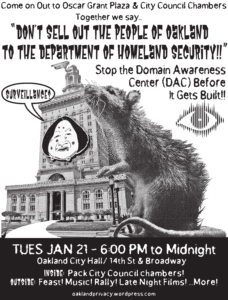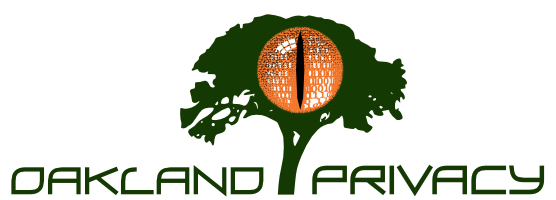
1999
- March. Urban Warrior. A military force “invades” Oakland as a training exercise. A precursor to “Urban Shield.”
2008
- DAC began with a grant from the Dept. of Homeland Security in 2008 to the Port of Oakland to secure port facilities “from terrorists.”
2009
- June. City of Oakland representatives signed a document to “Explore the Development of a Joint Port-OPD-OFD-OES Domain Awareness Coordination Center …”
- Sept. The Federal government tentatively approved a grant to the Port of Oakland for $2.9M to implement the Joint City/Port DAC.
2010
- July. Oakland City Council approves the $2.9M grant noted above.
2012
- ? (Jan-April) Final grant documents signed.
- Oct. A Request for Proposal to Implement Phase I of the DAC is sent out by the City of Oakland.
- ? Contract is given to SAIC.
2013
- Feb. Emails exchanged between SAIC and City officials discussing problems with Oakland’s Nuclear Free Ordinance (see below).
- April (?). SAIC completes Phase I, which “included the Design/build that would include equipment, services and the key City systems’ integration.”
- May. The Port of Oakland approves transferring “Port Security Grant” monies to fund Phase II of the DAC.
- June. Edward Snowden reveals documents describing how the Federal Government and the NSA have been spying on Americans (and everyone else) without regard to privacy and the 4th amendment.
- July. Current and former Occupy Oakland members become aware of the DAC.
- July 17th. Ali Winston, investigative reporter, writes an article published in the San Francisco Chronicle about the DAC: “Oakland Surveillance Center Raises Concerns” http://www.sfgate.com/crime/article/Oakland-surveillance-center-raises-concerns-4671708.php
- July 26th. A call on the Occupy Oakland calendar “to organize against the DAC” at the Sudo room is listed.
- July. The Oakland City Council approves receiving the Port Security Grant funds (some $2M) and gives a sole source, non-bid contract to SAIC to implement Phase II. OOPG members testify against the DAC at City Council. The vote includes a provision that the DAC will not become operational until a “privacy policy” is in place.
- August. City staff “discover” (reveal) that SAIC is involved or affiliated with nuclear weapons technology research or support, in violation of Oakland’s Nuclear Free Ordinance.
- August 15th. Second meeting to “organize against the DAC.”
- August 29th. Third meeting. The group is now called the “Occupy Oakland Privacy Working Group.”
- Sept. OOPG changes its name to the Oakland Privacy Working Group (OPWG).
- Oct. Oakland City Manager Deanna Santana decides to ask the Council to grant her permission to choose a new Phase II contractor from the set of four Phase I contractors whom they had rejected in favor of SAIC last year.
- Oct. OPWG begins to raise opposition to the DAC.
- Oct. 13th. New York Times article about surveillance “Privacy Fears Grow as Cities Increase Surveillance” in Oakland and the DAC.
- Nov 19th. City Council votes 6-1 (McElhaney objecting) to approve Santana’s request.
- Nov 27th. Darwin BondGraham and Ali Winston publish “Oakland Surveillance Contractor Lied On Official Documents” documenting the SAIC Nuclear Free Ordinance coverup. http://tinyurl.com/po4frc9_
- Dec (?) First DAC FAQ is created and printed.
- Dec. 30th: Al Jazeera published an article about the DAC and the opposition to it.
2014
- Jan 3rd. OPWG has a booth at First Friday, one of a few over the course of the battle against the DAC.
- Jan. Santana chooses Schneider Electric as the Phase II contractor.
- Jan. DAC opposition grows. OPWG meetings, held weekly at the Sudo room, start to have dozens of people show. Brian Hofer joins the group.
- Jan. OPWG creates an online petition against the DAC. Ultimately it is signed by more than 5000 people!
- Jan 24th. A “cease and desist” letter threatening a lawsuit on the basis of irregularities in awarding the Phase 2 contract is created by OPWG and others and ultimately delivered to the Council.
- Jan 28th. Schneider proposal comes before the City Council Public Safety Committee, where it is approved 3-0-1.
- Feb. Rally and march against the DAC, with giant rat puppet and posters, organized by OPWG. Cat Brooks, Mollie Costello, and Dan Siegel speak at rally.
- Feb. Negotiations amongst City Council members, the ACLU, the EFF and OPWG are held
- Feb 18th. More than 50 people testify in unanimous opposition to the DAC, including a number from the Lighthouse Mosque. City Council discusses scaling back the system to only handle Port Security and emergencies, then votes 6-0-2 to postpone a decision for two weeks.
- March 4th. After unanimous public opposition, the Council voted 5-4, Mayor Quan breaking the tie, in favor of a Port-restricted DAC. Had Quan voted against, or had Mayor-to-be Libby Schaaf abstained instead of voting ‘no,’ the DAC would have been killed outright.
- March. Stingray (cellphone surveillance) and ALPR (license plate reading technology) are raised as potential issues for OPWG.
- May. Ad Hoc Privacy Committee is formed, chaired by Brian Hofer, to write a privacy policy for the Port-restricted DAC. DAC remains offline.
- July OPWG officially endorses the Berkeley ‘no-tasers’ campaign.
- Sept. OPWG helps protest Urban Shield, resulting in a decision not to hold the militarized police training in Oakland in subsequent years.
- Oct. OPWG members help organize and run “Inside Urban Shield,” a report-back from reporters and others who attended the Urban Shield trainings and “weapons for sale” convention.
- Dec. OPWG members lead the charge to fund and acquire an “FOIA Document Scanner.” Josh Smith acquires the scanner.
2015
- Jan. OPWG members take part in organizing and protests against San Leandro acquiring an armored vehicle, to no avail.
- Jan. Meridith Sward of OPWG creates a Stingray video.
- Feb. Santa Clara Board of Supervisors approves purchase of a “Stingray.” This will later be rescinded.
- March. Ad Hoc Privacy Committee presents privacy policy to the City Council.
- March. FLIR becomes an issue (Infrared sensor on a helicopter) in Oakland.
- April. SB 34 (ALPR regulation for California) begins to move through the legislature.
- May. Oakland City Council approves privacy policy, technically bringing DAC online despite the Port of Oakland stating that they have no interest in providing funding for it. The City Council also approves the creation of an Oakland Privacy Advisory Commission, whose first task is to be to create a Surveillance Equipment Regulation Ordinance
- May. OPWG begins meeting at the OMNI. It had been meeting at the Impact Hub, and before that, at the Sudo room.
- June. PredPol (Predictive Policing) becomes an issue in Oakland. Council allocates $150K to purchase software.
- Sept. OPWG begins working with Santa Clara County Supervisor Joe Simitian, the ACLU and others to create and pass a Surveillance Equipment Regulation Ordinance in Santa Clara County.
- Sept. OPWG begins working with Alameda County Supervisors and the ACLU on an ordinance regulating the use of Stingrays and similar (cellphone intercept technology) by County law enforcement.
- Oct. OPWG members testify at Berkeley City Council against Tasers.
- Oct. OPWG members testify against Urban Shield participation by Berkeley to the Police Review Commission, to no avail.
- Oct. OPWG members testify at the Alameda County Board of Supervisors as to the nature of Stingrays and in favor of strict regulation.
- Nov 3rd. OPWG members testify against appropriating money to give OPD 121 additional shotguns to no avail.
- Nov 17th. Alameda County Board of Supervisors passes a Stingray regulation ordinance, allowing deployment only with a warrant and with other, significant restrictions.
- Dec 16th. Berkeley City Council votes not to enact a moratorium on Urban Shield participation by BPD. OPWG members testified in favor, created blown up photos (e.g. “Black Rifles Matter”) and created a video that was shown.
2016
- Jan. Legislation actually creating the Oakland Privacy Advisory Commission is finally passed into law. Appointments for the positions begin to be accepted.
- March. OPWG presents at RightsCon in San Francisco.
- April. It is revealed that BART is planning to install or has already installed Automatic License Plate Readers (ALPRs) at MacArthur Bart as a pilot program. OPWG takes the lead in making a stink about this, testifying before the Board and getting them to halt implementation until a privacy policy and more generally a Surveillance Equipment Regulation Ordinance (SERO) is created and approved.
- April 28th. First BART hearing on ALPRs. OPWG members testify against proposed pilot program.
- May 21. OPWG presents at Left Forum in New York City.
- June 7th. Santa Clara County becomes the first jurisdiction in the nation to pass a Surveillance Equipment Regulation Ordinance
- Jun 21st. Oakland Privacy Advisory Commission appointees approved by City Council.
- July. The first meeting of the Oakland Privacy Advisory Commission happens. Brian Hofer is elected as chair.
- July. OPWG presents at the HOPE conference in New York City.
- July. Members vote to change the name of OPWG to simply “Oakland Privacy” and to adopt a somewhat revised logo, replacing the “Eye of Sauron” with a digitized eye.
- July. Meetings begin with Oakland Privacy, ACLU and BART officials and BART police to draft a SERO.
- July. Oakland Privacy discovers that CALIBRE Press will be training police in “shoot first” tactics in the Bay Area, and makes a stink, with much press being generated. The Santa Clara sheriff, which was to sponsor the event, withdraws support.
- August. The CALIBRE training takes place at a private location in San Jose.
